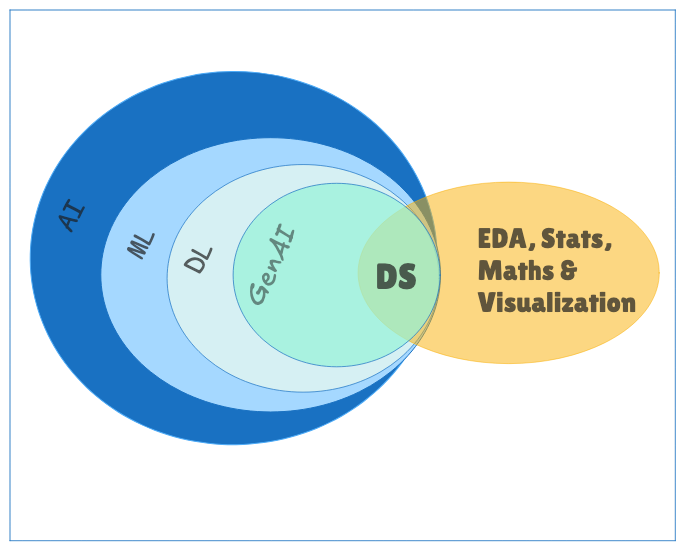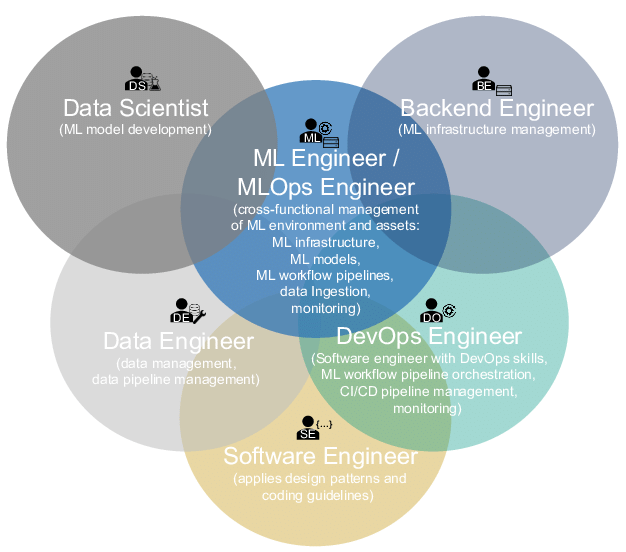How to Kickstart Your Journey as a Machine Learning Engineer
Your guide to production-ready machine learning
The world of AI is evolving at a breakneck pace, and it’s easy to get lost in a sea of titles: Data Scientist, AI Engineer, and Machine Learning (ML) Engineer. While they all work with data, they have distinct roles. I’ve often been asked: Where do I even start if I want to become a Machine Learning Engineer?
This guide is my attempt to answer that question by breaking down the landscape, sharing my own journey, and offering a practical, self-study roadmap.
The Landscape: AI, ML, DL, and GenAI
Let’s quickly untangle the jargon:
AI (Artificial Intelligence): The broad field focused on making machines exhibit human-like intelligence. It includes reasoning, problem-solving, perception, and learning.
ML (Machine Learning): A subset of AI that focuses on creating algorithms and models that learn from data and make predictions or decisions. The goal of ML is to enable computers to learn from experience, identify patterns, and automate tasks without being explicitly programmed for every possible scenario. Think of it as building a "smart" system that can adapt and improve over time.
DL (Deep Learning): A further subset of ML using complex neural networks with many layers to learn from massive datasets, ideal for tasks like image recognition, speech processing, and natural language understanding.
GenAI (Generative AI): A subfield of DL/AI that creates entirely new content (text, images, music) using models like GANs and large language models. Its focus is on generation, mimicking human creativity. Transformers (from Google’s 2017 Attention Is All You Need paper) reshaped this space and pushed the industry toward generative AI applications. Today, large language models (LLMs) like GPT and Claude are central to this field, enabling natural language generation, reasoning, and interactive applications.
DS (Data Science): The study of data that helps us derive useful insight hidden within data for business decision making. It combines math, computer science, and domain expertise to tackle real-world challenges in a variety of fields. Data scientists often use ML as a tool for analyzing data and building predictive solutions, but DS also involves many other skills and techniques beyond ML.
Why Machine Learning Engineering?
Unlike Data Science, MLE is not usually the first role someone lands. It’s best suited if you already have a foundation as a software engineer or data scientist. It's a role that combines strong coding fundamentals with an understanding of machine learning principles and an emphasis on deployment and scalability.
Data Scientists: Explore data, build models, prototype in notebooks.
Machine Learning Engineers: Productionize those models—deploy, scale, and monitor them reliably.
Think of it like this: the Data Scientist writes the recipe; the ML Engineer runs the kitchen at scale.
MLE responsibilities include:
Deploying models on the cloud (AWS, Azure, GCP)
Containerization (Docker, Kubernetes)
Building CI/CD pipelines for ML
Model versioning, testing and Validation
Monitoring models (accuracy drift, latency, system uptime)
Optimizing model and infrastructure performance
My Journey
Foundation in Coding
I studied IT in college (Java, C, Data Structure & algorithms). Later, I picked up Python through YouTube tutorials and Coursera’s Python for Everybody specialization. I also practiced on coding platforms like HackerRank and CodeChef.Data Engineering First
I began as a Data Engineer – working with data pipelines SQL, Spark, and distributed data systems.Shift to Data Science
With self-study (Andrew Ng’s ML course, Khan Academy math refreshers) and collaborating with my organization’s Data Science team, I moved into Data Science. I learned classical algorithms like regression, classification, decision trees, clustering, random forests, and feature engineering.Bridging into MLE
Over time, I learned the engineering side: containerization, cloud deployments, CI/CD, and MLOps. This was the step that took my ML knowledge into production systems.
A Practical Roadmap for Aspiring MLEs
Step 1: Solidify Your Programming Foundation
If you've got a background in IT or software development, you're already ahead. Python is the language of choice for machine learning, so if you're not already proficient, it's time to get started.
Don't worry about learning every advanced feature right away. Focus on the core building blocks:
Data Structures: Lists, tuples, dictionaries, and sets.
Control Flow: for and while loops, if/else statements.
Functions and Classes: How to write clean, reusable code.
A great resource for this is Coursera's "Python for Everybody Specialization" which can get you up to speed in just a few days to weeks.
Step 2: Brush Up on Your Math and Statistics
You don't need a Ph.D. in mathematics to get started, but a solid grasp of key concepts is essential for understanding how models work. Think of it as understanding how a car engine works before trying to race it.
Focus on these areas:
Linear algebra: vectors, matrices
Calculus: derivatives, gradients
Probability & statistics: distributions, hypothesis testing
Khan Academy is an excellent, free resource for refreshing these topics. You can learn just enough to understand the "why" behind machine learning algorithms without getting lost in the weeds.
Step 3: Dive into the Machine Learning Toolkit
With your programming and math fundamentals in place, it's time to start working with the tools of the trade:
NumPy: For efficient vector and matrix operations
Pandas: Data manipulation and analysis
Matplotlib & Plotly: Visualization libraries
Scikit-learn: Most popular library for classical machine learning algorithms
Deep learning frameworks: Pytorch, Tensorflow
Start by working on small projects with datasets from platforms like Kaggle. This hands-on experience is invaluable.
Step 4: Grasp Machine Learning and Deep Learning Concepts
Begin with classical ML algorithms:
Feature Engineering: Preparing and transforming data
Classical Models: Linear regression, logistic regression, decision trees, random forests, clustering
A fantastic resource for this is Andrew Ng's Machine Learning Specialization.
Step 5: Deep Learning (Applied path)
As you progress, dive into deep learning. While the field can be complex, you don't need to be a research scientist to apply it. Focus on practical applications:
Fundamentals: Understand the basics of neural networks. Andrew Ng's Deep Learning Specialization is the gold standard here.
Transformers and Generative AI: The 2017 "Attention is All You Need" paper revolutionized AI, and now transformers are everywhere. Explore the transformer paper (the backbone of today’s models) and watch Andrej Karpathy’s lectures on neural networks, transformers, and large language models (LLMs).
✨ Large Language Models (LLMs), such as GPT, are the most popular application of transformers. You don’t need to train an LLM from scratch (that requires huge compute and data), but as an ML Engineer, you should understand how they work at a high level and, more importantly, how to apply them. This includes fine-tuning existing models, integrating them into pipelines, and leveraging APIs for production use.
Step 6: Master Deployment & MLOps
This is the key differentiator for an ML engineer. While a Data Scientist might stop at a Jupyter Notebook, an MLE makes the model a reliable, scalable system. This is where your software engineering skills truly shine.
Cloud Platforms: Learn the fundamentals of major cloud providers like AWS, Azure, or GCP. Understand services for model deployment, such as AWS SageMaker.
Containerization: Use tools like Docker to package your code and its dependencies into a single, portable container. This ensures your model runs the same way on your laptop as it does in the cloud.
Orchestration: For complex systems, you'll need Kubernetes to manage and scale your containers.
MLOps: Build CI/CD pipelines, monitor performance, track versions, and automate deployments.
Great resources: O'Reilly Practical MLOps and Designing Machine Learning Systems.
Step 7: Generative AI & Advanced Topics
At this stage, you can start exploring more advanced areas. Generative AI is one of the hottest topics right now, and ML Engineers play a big role in making it practical.
LLMs, for example, require engineering to make them useful in real-world applications. This includes:
Building Retrieval-Augmented Generation (RAG) pipelines,
Managing vector databases for embeddings,
Handling model monitoring, and
Optimizing deployment costs.
These are engineering challenges, rather than research problems, and solving them is where you’ll add real value as an ML Engineer.
Final Thoughts
Becoming a Machine Learning Engineer isn’t about mastering every detail of AI research. The field evolves rapidly, so it’s important to stay updated with blogs, newsletters, and new frameworks – but without getting lost in the noise. At its core, MLE is about bridging data science and software engineering, transforming models into production-ready systems that make a real impact.
If you enjoy coding, working with data, and are curious about deployment and scalability, this career path can be both exciting and deeply rewarding.
What part of this journey resonates most with you? Reply or comment – I’d love to hear how you’re approaching your path into ML Engineering.



This is really helpful guide!
Welcome to the club.
Well written. Keep it up!